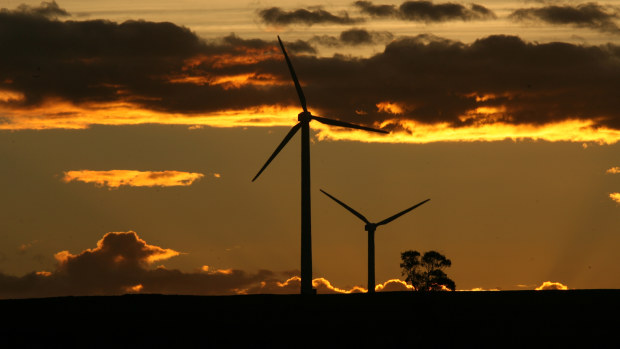NSW energy plan raises worries on risks for consumers

Renewable energy investors say the NSW government's 20-year strategy to replace almost all coal-fired generation with renewables backed by storage will be a huge driver of investment to meet emissions goals, but others are worried about potential increased costs for consumers and distortions to the national energy market.
The NSW government's Electricity Infrastructure Roadmap, released on Monday, will harness the power of private markets to accelerate the transition to clean energy, said Simon Corbell, chairman of the Clean Energy Investor Group, whose members include Macquarie Capital and US investment giant BlackRock.
He said the plan, which reinforces NSW's path towards its net-zero emissions goal by 2050, provides policy certainty and distinct market signals for investment in Renewable Energy Zones, both in renewable generation and transmission networks.

The NSW energy plan will reduce risks for investors in wind and solar farms. Andrew Taylor
It provides "critical market clarity" to help draw global capital to the $63 billion of investment opportunities estimated to arise by embracing policies aligned with the Paris climate agreement, said Emma Herd, chief of the Investor Group on Climate Change.
But traditional energy suppliers and users are much more wary, voicing concerns about potential costs and risks for customers. In particular, they are concerned about the move in the NSW road map to introduce financial mechanisms that reduce project risk for renewable energy developers by guaranteeing floor prices. They are also critical of a NSW-specific target for electricity reliability.
"I understand why NSW is doing it, but I don't think this is the best answer," said Grattan Institute energy program director Tony Wood.
"It transfers too much risk from investors to consumers and taxpayers. The idea is to transfer basically as much risk as possible away from the project proponent so they will get the lowest possible price – and of course that works ... but the risk doesn't go away because you've given it to somebody else."
Australian Energy Council chief Sarah McNamara said existing mechanisms in the National Electricity Market already encourage investment in new generation and that government underwriting of specific power projects could distort market signals for private generators.
Ms McNamara noted that the market is designed to intentionally place risks around investment projects on investors rather than pass those to consumers. She called the NSW-specific reliability target as "excessive" and said that could lead to an over-build of energy assets, meaning higher costs for households.
The road map says energy prices will fall for consumers due to the measures, citing an average annual saving of $130 for households and $440 for small businesses.
More broadly, energy suppliers and users are worried about the further evidence of a breakdown in the country's national approach to energy policy, with NSW, Victoria and Queensland all having net-zero emissions goals by 2050 but choosing different ways to reach them in the absence of a lead from Canberra.
Mr Wood said the NSW plan seemed to cut across the work being led by the Energy Security Board on the post-2025 redesign of the National Electricity Market.
Andrew Richards, the head of a group representing large energy users, urged state governments to re-commit to a national approach to energy to avoid introducing competing policy and regulatory frameworks that lead to inefficiency. Ai Group head Innes Willox welcomed the certainty the plan provides for investors but highlighted the risks being taken as states went their own ways in the energy market.
Still, NSW energy minister Matt Kean said the state government "remains committed" to a national framework for energy.
"That's why the road map is designed to integrate with the national market and the post-2025 review," he told The Australian Financial Review.
"But the NSW government is always going to put NSW consumers first and the majority of NEM states already have a state-based mechanism to drive investment."
Ensuring consumers don't pay more for power and NSW businesses get their fair share of the work arising from the investment will be Labor's key focus, said NSW's shadow minister for climate change and energy, Adam Searle, who said the road map appears to borrow heavily from NSW Labor's 2019 election energy policy.
"While we have some concerns about aspects of the plan, particularly around the lack of commitment on local jobs and manufacturing, Labor will provide in-principle support for these measures, subject to seeing the final details and working through our concerns and proposals for improvement."
While NSW grid owner welcomed the road map, the big three energy suppliers, Origin Energy, AGL Energy and EnergyAustralia, all reserved judgment as they examine the detail, hinting at some concerns.
"We will be taking time to carefully review the road map’s specifics and its potential impacts to customers, the communities in which we operate and our business as a whole," an EnergyAustralia spokesman said.
Origin wants to understand "how the government will ensure it complements the detailed national planning being undertaken by the Energy Security Board as part of its NEM 2025 work," a spokeswoman said.
Subscribe to gift this article
Gift 5 articles to anyone you choose each month when you subscribe.
Subscribe nowAlready a subscriber?
Introducing your Newsfeed
Follow the topics, people and companies that matter to you.
Find out moreRead More
Latest In Energy
Fetching latest articles